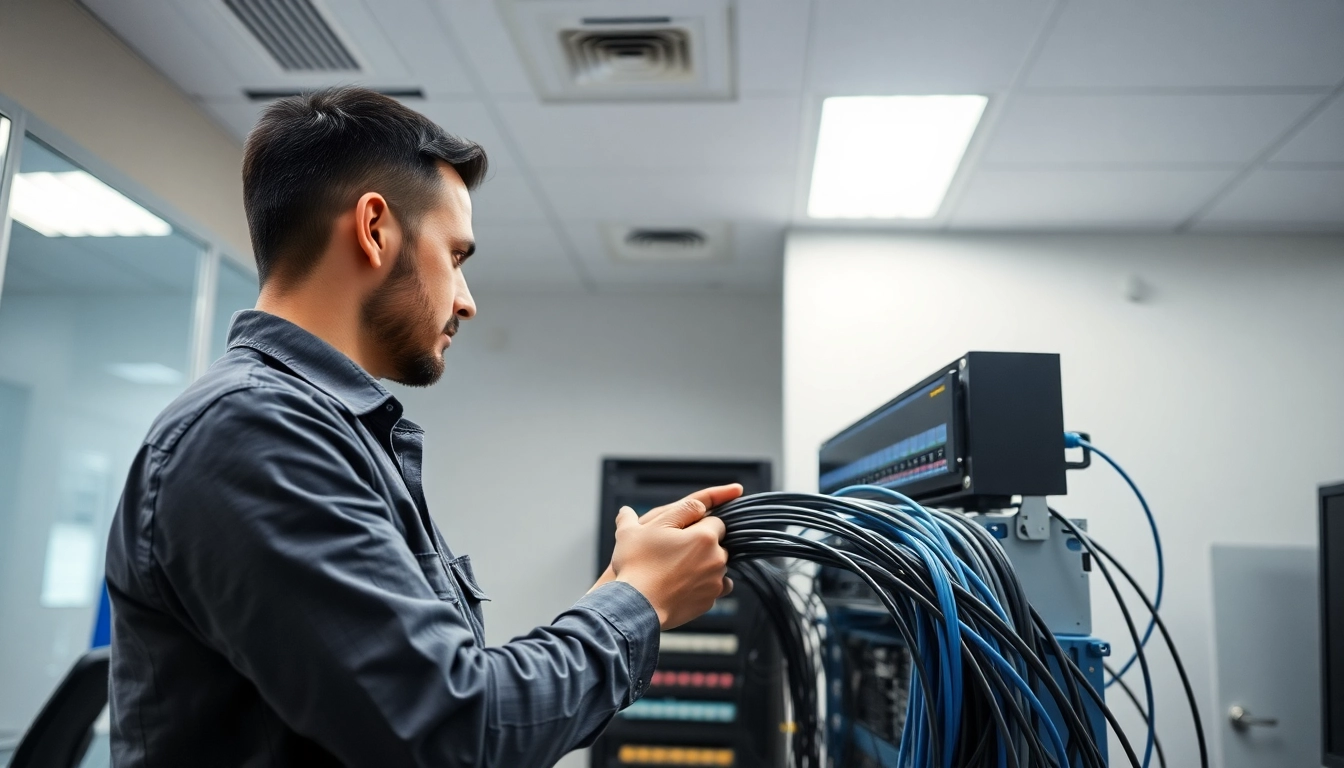1. Understanding Data Cable Installation Services
What is Data Cable Installation?
Data cable installation refers to the process of connecting various electronic devices and systems to enable the transfer of data and signals. This service is crucial for both residential and commercial users, ensuring that everything from computers, printers, and servers to audio-visual equipment is interconnected and functioning optimally. Data cable installation can involve the use of different types of cables, including Ethernet cables, fiber optics, and coaxial cables, each serving a specific purpose based on speed, distance, and data capacity requirements. By relying on professional Data Cable Installation service, users can ensure that their network infrastructure is robust and reliable.
Types of Data Cables Used in Installations
When it comes to data cable installation, understanding the types of cables available is vital. The most common types include:
- Ethernet Cables: These cables are typically used in LANs (Local Area Networks) and come in various categories such as Cat5e, Cat6, and Cat6a, each offering different speed capabilities and bandwidth.
- Fiber Optic Cables: These cables use light to transmit data and can cover much longer distances than copper cables without signal loss. They are ideal for high-speed internet connections and large data transfers.
- Coaxial Cables: Often used for television signals and internet connections, coaxial cables feature a single copper conductor surrounded by insulation and shielding, helping to prevent interference.
The Importance of Reliable Installation Services
The significance of reliable data cable installation services cannot be overstated. A properly installed data cable network enhances speed, reduces downtime, and ensures network longevity. Additionally, professional installers are knowledgeable about best practices, local regulations, and safety standards, minimizing the risk of accident or malfunction that can arise from improper installation. Moreover, a well-structured wiring system facilitates easier upgrades and maintenance, positively impacting overall system performance and obtaining greater return on investment.
2. Benefits of Professional Data Cable Installation Services
Enhanced Network Performance and Speed
One of the primary benefits of opting for professional data cable installation is the enhancement in network performance and speed. Skilled installation minimizes the chance of cabling issues, which can lead to slow connectivity and interrupts in service. A professional installer understands how to optimize the routing of cables, minimizing interference and maximizing data transmission speed. This is particularly important in environments with high usage, such as offices or data centers, where uninterrupted connectivity is crucial.
Safety Standards and Compliance
Another compelling reason to hire experts for data cable installation is adherence to safety standards. Installers are trained in local codes and regulations concerning low-voltage electrical work, ensuring that installations are compliant and safe. This is particularly vital in densely populated spaces or industrial environments where multiple electrical systems coexist, posing potential hazards without proper installation. Additionally, compliance helps to maintain warranties on both equipment and installation services, providing peace of mind to clients.
Long-Term Cost Savings and Reliability
Investing in professional data cable installation can lead to significant long-term cost savings. While the initial costs may seem higher compared to DIY solutions, the expertise of professionals often translates to fewer repairs and maintenance issues down the line. A correctly installed cable system operates more efficiently, leading to lower operational costs and reduced energy consumption. Furthermore, reliability is crucial; a stable network reduces the risk of downtime, which can severely impact operations and revenue in a business context.
3. Common Challenges in Data Cable Installation
Identifying Technical Issues Before Installation
Before beginning a data cable installation, it’s essential to identify any existing technical issues that may affect the performance of the new setup. Assessing the current network infrastructure can help pinpoint problems such as bandwidth limitations, outdated hardware, or improper configurations that could hinder the effectiveness of new installations. Professionals conduct thorough assessments, ensuring that all variables are accounted for and that the installation is set on a solid foundation.
Dealing with Space Limitations and Planning
Space limitations can present a unique set of challenges during data cable installations. Proper planning and design are essential to maximize the available space without compromising functionality or aesthetics. Professionals are equipped with strategies for routing cables efficiently within walls, ceilings, and floors, ensuring a neat and unobtrusive installation. They can also effectively manage areas with existing electrical systems, reducing the risk of interference.
Ensuring Proper Testing and Verification
Once installation is complete, thorough testing and verification of the network setup are vital to ensure optimal performance. Professionals conduct various tests to confirm that signals are transmitted effectively and that there are no dead spots or malfunctions within the network. This may include cable certification testing to validate performance against the specifications of the installed cables, ensuring functionality and reliability before the system goes live.
4. Choosing the Right Data Cable Installation Provider
What to Look for in a Service Provider
When selecting a data cable installation provider, it is important to consider several factors. Look for a company with proven experience in the field, as well as relevant certifications that indicate a high level of expertise. Additionally, the breadth of their services should align with your specific needs, whether for a residential setup or a complex commercial project. Insured and bonded professionals can further protect you from potential liabilities.
Understanding Pricing Models and Quotes
Understanding pricing models is critical in choosing a data cable installation provider. Some companies may charge flat rates, while others may base their fees on the complexity and size of the project. It’s advisable to request detailed quotes that outline labor, materials, and any additional costs that may arise. The pricing should reflect the anticipated level of service and quality of materials, ensuring you receive value for your investment.
Importance of Customer Reviews and Testimonials
Customer reviews and testimonials can provide invaluable insight into a service provider’s reliability and quality of work. Positive feedback from previous clients can be indicative of a trustworthy service. When evaluating providers, consider their reputation in the industry, as well as any ratings or awards they may have received. Engaging with real customer experiences can also aid in gauging the company’s customer service and support.
5. Tips for Maintaining Your Data Cable Network
Regular Inspections and Upgrades
To ensure the longevity and effectiveness of your data cable network, regular inspections are essential. Schedule routine checks to examine cables for wear and tear, and address any potential issues before they escalate into significant problems. Periodic upgrades may also be necessary, particularly as technology evolves; staying current with advancements can help maintain optimal performance and efficiency.
Avoiding Common Damages to Data Cables
Data cables can be prone to various forms of damage, including physical wear, water exposure, and electrical interference. To mitigate the risk, ensure that cables are installed in protective conduits or underground where applicable, using proper cable management solutions to minimize strain and bends. Protecting cables from moisture and extreme temperatures is also essential, particularly in industrial environments.
How to Troubleshoot Basic Issues
For minor connectivity issues, basic troubleshooting steps can often be sufficient before calling in a professional. First, check for loose connections, and confirm that all cables are securely attached and undamaged. Restarting the network device can also resolve many common problems. If connectivity issues persist, consider utilizing tools like network analyzers or cable testers to identify specific failures in the cabling system.



